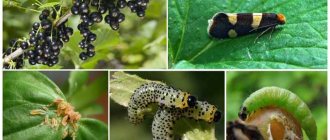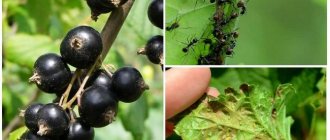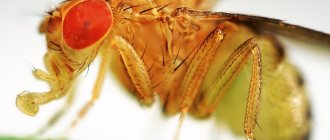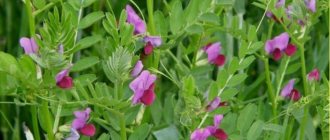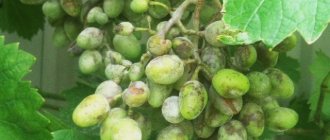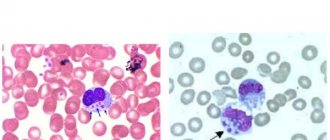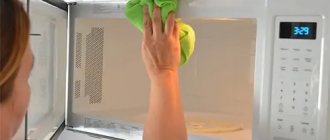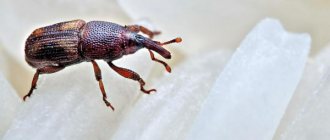Without guile, we can say that aphids are one of the most terrible pests in a summer cottage. Monstrously tenacious and prolific creatures infect a huge number of garden and vegetable crops; the most “annoying” is the melon aphid, which attacks cucumbers. It is also able to settle on roses, fruit trees (especially apple trees) and, of course, on berry bushes, which, unfortunately, are also not spared. To combat a small pest, you need to constantly apply a number of measures aimed at preventing and protecting currants, as well as gooseberries. Moreover, these can be both folk remedies and chemical preparations against pests (insecticides). Today we will talk about one of these pests, the gall aphid, which causes quite significant damage to currants, affecting both the appearance of the plant and its yield in a negative way.
Gall or leaf aphid description
Aphids on currants are a common problem; you need to know how to fight them in order to preserve the harvest. Proper care not only prevents insect attacks, but also protects the crop from possible diseases carried by aphids. Gall or leaf
aphids most often appear on red and white currants, but in some cases they appear on chokeberries. The red gall aphid causes great damage to the crop, which manifests itself in the form of red and brown seals on the foliage. An infected bush quickly loses its vitality and leads to a lack of harvest. Aphids appear on red and white currants due to the fact that the leaves of the crops are more tender and juicy.
Useful articles for gardeners and gardeners
Cucumbers, planting seedlings in open ground,
fertilizing raspberries with mineral fertilizers
Planting beets in open ground with seeds
Rose diseases description with photographs and methods of treatment
The size of adult aphids is 2.2 - 2.5 mm, coloring from lemon yellow to brown. Eggs laid in autumn overwinter in cracks in the bark near the buds. The emergence of pests begins quite early, when the leaves bloom. External signs of damage - galls - appear on the leaves during the formation of ovaries.
During the season, depending on the weather, aphids produce from 4 to 19 generations. Pests become active in early spring, almost immediately after the snow melts. Initially they attack weeds, but gradually move on to currants. Pests hide on the back of the leaves and spend their entire lives on one bush.
In order for the control of gall aphids on currants to be effective, colonies of garden ants should be destroyed. Insects protect pests because they give them sweet juice. Anthills should be dug up and filled with boiling water, covered with ash, or moved to another place.
As a rule, the peak activity of aphids occurs in May-June, although the pest does not sleep during the summer, actively reproducing and populating the entire garden with its offspring.
Prevention of infection
To prevent aphids from attacking your plantings and protect your currants, think about prevention long before they appear. Following simple principles and control measures will help with this:
- Weed control. Overgrown bushes are much more likely to be affected by pests, so the area around the currants should always be thoroughly weeded. The only exceptions may be repellent plants.
- Timely pruning of bushes will also help protect currants. Aphids breed on branches hidden from the sun and poorly ventilated. You can prevent its comfortable reproduction with the help of annual sanitary and formative pruning: dead branches and excess weak shoots hidden in the depths of the bush are eliminated.
- Destruction of ants. Black ants will ruin all your attempts to remove aphids. They carry it on themselves from neighboring areas, populating more and more new bushes. Therefore, black ants must be fought tirelessly until they are completely destroyed.
The key to success in the fight against aphids is methodicality. By noticing the appearance of pests in time, you can avoid infection of all plantings. It is impossible to completely get rid of aphids on red or black currants. However, compliance with preventive measures and a competent combination of control methods will help avoid significant damage to the crop and maintain the health of the bushes.
How to detect aphids on currants?
Among the main signs of aphid infestation are:
- reddish swellings in the central part of the leaves;
- red-brown growths appeared on the branches;
- the leaves curl and then dry out;
- The bush grows slowly, the shoots are weak.
Harm
Consequences of insect activity on the branches and damage caused:
- Deformation of sheet plates.
- Attracting other pests - beetles, ants.
- Depletion of shoots and their drying out.
- Reduction in yield down to minimum values.
- Spread of various viral infections.
- Stopping the growth of new shoots and green mass.
- Complete death of the bush.
Traditional methods of combating Gall aphids
An attentive gardener will not miss the appearance of gall aphids on currants; he will immediately take adequate control measures. It is important to notice the deformation of young leaves at the initial stage of the growing season. On them, galls look like small red spots. In addition, the presence of the pest last season is a serious reason to begin preventive measures on the bush as early as possible.
Useful articles for gardeners and gardeners
New moon in June 2021 when from what date to what date
Moon phases in June 2021 by days for landing
Strawberry jam with whole berries 5 minutes classic recipe
Waning moon in June 2021: when and from what date?
If a gardener finds aphids on currants, what folk remedies should be used?
- Potato infusion. Prepared from the dry tops of this plant, it can save almost any shrubs from aphids. Green potatoes are cut and poured with warm water, in which they should steep for 3 hours, then the affected currant bushes are treated with it. It may also be useful for you to know what remedies exist for powdery mildew on currants.
- Infusion of wormwood. To 5 liters of water you need to add 0.5 kg of fresh chopped wormwood, 45 g of laundry soap and 1 tbsp. wood ash. Then the prepared solution should be allowed to stand for 5 hours and diluted with water in a ratio of 1:2.
- Garlic infusion. You need to add 500 g of crushed garlic cloves to 5 liters of water, and then leave the product for 24 hours, filter it and use it to spray the bush.
- Ammonia. Ammonia against aphids helps get rid of pests, saturates the plant with nitrogen, accelerates growth and fruit formation, and helps cope with damage to the bush. Important! Ammonia for aphids is used on a bush once. Repeated treatment is allowed 2 weeks after the previous one. Otherwise, the currant bush will suffer from an excess of nitrogen. The leaves will begin to turn yellow and curl. Ammonia against aphids is effective for 3 days. During fruiting, it is necessary to use the safest means possible. Soda for aphids is one of them. Use food grade, calcined. The bush can be treated with the same product during flowering. Baking soda saturates the plant with calcium, promotes the formation of fruits, destroys pathogens, and prevents diseases.
- Dandelions, which begin to appear everywhere with the arrival of warmer weather, can be used to eliminate insects. You will need to take 600 grams of flowers, pour them into containers of a suitable size with 10 liters of water. After soaking for no more than 3 hours, it is permissible to treat shrubs with the prepared infusion.
- A decoction of alder leaves is also often used. 1 kg of them should be infused in 5 liters of liquid. After the solution has boiled for no more than half an hour, it needs to be cooled and can be used to treat shrubs.
- Infusion of red hot pepper. You can prepare a concentrated infusion from red capsicum. To do this, cut 1 kg of fresh pepper and put it in a saucepan, add 10 liters of cold water. Bring the mixture to a boil and cook over low heat for 1 hour. The cooled solution is stored in a warm place for several days. The finished solution is filtered and stored in the cold. For spraying, a working solution is prepared from the concentrate. For 10 liters of water use 1 glass of concentrate. You can add grated laundry soap to the solution as an adhesive. The ready-made working solution and red hot pepper are used not only in the fight against aphids. It is good to use against slugs.
Important! Treatment with folk remedies is effective at the initial stage of infection. If insects have spread over large areas, it is much more effective to destroy them with chemicals.
The most common pests
Ognevka
The most common one, the gooseberry moth, is a representative of the biological order Butterfly. It has small dimensions and gray wings. The location of the pupae of wintering moths is in the soil, under bush currant plantations, which complicates the process of controlling moths on currant bushes. Their appearance occurs in the spring when the air temperature is stable and warms up to +13°C. The cavities of currant bush flowers serve as a reservoir for the ovipositor. The number of moth individuals on one bush can reach two hundred. Caterpillars appear a week after laying eggs. You need to know what the currant moth cannot tolerate and how to deal with its appearance, otherwise its constant presence in the garden will lead to the death of the currant planting. Timely measures taken to combat the gooseberry moth will allow you to preserve the ripe crop.
Damage to gooseberry moth
Important! The moth caterpillar is one of the most active fruit eaters. One insect does this instantly, eating 15 pieces of a ripening currant crop at a time.
How to treat red currants against Gall aphids?
Currently, there are many effective chemicals on sale that can kill aphids on currants.
The most famous of them:
- Intra-Vir;
- Aktara;
- Karbofos;
- Wofwtox;
- Rovikurt;
- Kinmiks and other similar insecticides.
The first treatment of currants against aphids should be carried out in early spring, before the buds on the bush begin to bloom. When young leaves appear, the treatment should be repeated. And in July, the third treatment of plants is carried out.
Important! However, 25-30 days before picking ripe berries, it is no longer possible to treat currant bushes with insecticides.
Types of currant pests and “symptoms” of lesions
There are many different types of gall midges in nature - about 6 thousand. Pests of this family mainly attack fruit bushes and fruit-bearing trees. Gardeners, in addition to currants, are probably familiar with raspberry and pear gall midges: they are also frequent guests in the garden. Among these pests there are also “admirers” of grain crops.
Currant gall midges are yellow-brown dipterous insects. They are small: the length of adults is a maximum of 4 mm. Externally, insects are similar to mosquitoes, but with long antennae and hairs on the body. The caterpillars of the long-whiskered nasties are initially white, and as they develop they become red-orange.
There are only three “currant” varieties of gall midges. The difference between them is insignificant - tastes: some prefer to eat leaves, others - shoots, others like flowers.
- Flower gall midge. Insect larvae infect the buds. They seem to swell, become pale yellow or take on an unnatural purple hue. Deformed buds fall off. As a result, productivity decreases.
- Stem gall midge. The pest can be found in scratches on the stems or cracks in the bark. The larvae actively feed, which is why the bark begins to die and the shoots dry out. With severe damage, the bush dries out completely.
- Leaf gall midge. The most common type. You can determine that a pest has chosen a bush by its deformed leaves of an unnatural color. Colonies of larvae prefer to live in young leaves. With severe damage, the leaves become deformed, they turn brown, curl, and dry out. If there are few larvae, then the young leaf continues to develop, but the activity of pests does not go unnoticed - the leaf plate becomes asymmetrical and very torn.
Gall midges are especially dangerous for young plants: annual bushes can die if they cannot withstand the attack of pests. Insects reduce yields by up to 70%, so the gardener should not let the situation take its course.
How to deal with gala aphids on black currants
CURRANT. Fight against stem gall midge. Video instructions from the Nursery "Gardens of the Urals"
control of gall midge on currants and viburnum
Biochemical method of combating Gall aphids
When the gall aphid has already multiplied, it is impossible to do without chemicals to combat it. Considering the toxicity and shelf life of toxic components in plant tissues, it is recommended to spray currants with insecticides at the budding stage, and a second time after harvesting. Spraying with Calypso, Confidor Maxi, Aktelik, Vofatox, Proteus gives a long-term effect.
Useful articles for gardeners and gardeners
Cherry diseases description with photographs and methods of treatment
Homemade rose petal jam recipe
Dandelion jam recipe: benefits and harms
How to ferment young cabbage at home?
In addition to chemical insecticides, a modern “herbal pharmacy” offers biological preparations that are harmless to humans and domestic animals. They are made from spore bacteria, fungal components, and viruses. Entering the insect's body with food, they affect the intestinal tract, paralyzing and destroying it. Examples of such drugs are Avertin, Actofit, Bitoxibacillin.
Acrophyte in the fight against Gall aphids
Acrofit is a concentrated solution of aversectin C with paralytic action. Sold in 40, 200 and 900 ml packaging, as well as in 4.8 liter bottles. When caught on the body of an aphid, it causes instant paralysis. The infected insect dies within 48 hours after treatment. The drug is resistant to precipitation and remains in the plant for 2-3 weeks. Pests drinking the juice of treated currants die out after 2-3 days. Acrofit is not addictive. Acrophyte is not used during flowering.
The optimal time for spraying is dry, windless weather at a temperature of +20 °C. For spraying, 8 ml of the substance is diluted in 1 liter of water. Bushes and berries are treated with the prepared solution. The fruits are edible after 2-3 days. Repeated spraying is carried out after 2 weeks. The solution is not suitable for storage; the active substance avesectin decomposes in water.
Finally:
Fighting gall aphids is not difficult if you begin to destroy the pest immediately after its detection. After the end of the growing season, it is imperative to carry out preventive measures. They will help prevent a strong spread of the pest next year.
Gallica
Gall midges are a type of small flying insects similar to mosquitoes. The affected area where the gall midge has settled on currants can be any part of the plant. Adults are 2 mm long and have a yellow-brown color. Initially white, as they develop the color of the caterpillars changes to red-orange, and at the last stage of growth it turns into red.
Note. Black currant varieties are most susceptible to damage by gall midges.
There are three varieties of gall midge:
- Leafy ones that damage young leaves by eating and settling on them. A leaf damaged by leaf gall midges does not develop, curls and falls off. Young shrubby shoots are most susceptible to leaf gall midge invasions;
- Flower gall midges lay eggs in the ovaries of flowers, which leads to the death of the inflorescences, which acquire a spherical shape. Saturated larvae move from the bud to the soil;
- Stem gall midges select cracked fragments of the trunk of currant bushes for ovipositor. This happens at the end of the flowering stage. For nesting, the larvae choose a place under the bark, where huge colonies are formed. Fragments of bark inhabited by stem gall midges, as well as shoots, die.
Important! Large-scale damage by stem gall midges will lead to the loss of more than 70% of garden plantings, not only currants, but also gooseberries.
While in the larval stage, each of the above representatives of the gall midge species overwinters in the upper layer of soil. Pupation of caterpillars begins with the onset of stable warming. With the transition of the bush to the flowering stage, mature individuals are activated.
Weevil
The bud weevil is a beetle with a gray color and belongs to the short-proboscis type. Representatives of these parasitic insects are characterized by a bisexual method of reproduction. Mature individuals eat the vegetative organs of buds and flowers. The place for laying eggs is located next to the currant planting. The development of bud weevil larvae occurs in fruits and stem tissues. Knowing how to prevent the appearance of weevils on currants and how to deal with this pest, you can prevent loss of yield.
All weevils are divided into two types:
leaf roller
The leaf roller is a 3-centimeter moth whose wings fold exactly horizontally. The larvae are yellow-green in color. The number of eggs laid at a time is about a hundred. The caterpillars are distinguished by a black head with rows of peculiar hooks on the sides of the body, which is devoid of hair. In addition to destroying leaves, leaf rollers also eat buds. The overwintering place for the currant leaf roller is leaves shrouded in cobwebs.
